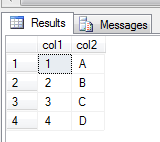Background
To test queries and concept, I am using SQL SERVER 2008 R2.
Introduction
There are several requirements where we need to pass temp table data to called stored procedure for further processing and can return manipulated data to parent stored procedure. I want to evaluate some of the good ways to accomplish this. I shall test approach for concurrent calling.
Table Valued Function – This can be a good approach. But the limitation is that you can’t call stored procedure inside function if you need to.
Using Temp Table - This approach looks promising. It works for in and out.
Passing table variable – By any chance if you are using insert into in both parent and child stored procedures. Then it fails.
Other approaches like Using Cursor Variables, CLR, Open query or XML are complex, non efficient or having other pitfalls.
Evaluation of Data Sharing Using Temp Table
Let's evaluate the most promising approach. Test - whether temp tables are call dependent and not, causing problem in other calls.
Create a table named as mytable.
CREATE TABLE [dbo].[MyTable](
[col1] [int] NOT NULL,
[col2] [char](5) NULL
) ON [PRIMARY]
Let's insert some sample rows for test.
INSERT INTO [MyTable]
([col1],
[col2])
VALUES (1,
A)
Go
INSERT INTO [MyTable]
([col1],
[col2])
VALUES (2,
B)
GO
INSERT INTO [MyTable]
([col1],
[col2])
VALUES (3,
C)
Go
INSERT INTO [MyTable]
([col1],
[col2])
VALUES (4,
D)
Go

Create child stored procedure named as called_procedure. Here, first I am checking whether temp table is existing or not. If it exists, then insert some data as per passed parameter @par1.
IF EXISTS (SELECT *
FROM sys.objects
WHERE object_id = Object_id(N'[dbo].[called_procedure]')
AND type IN ( N'P', N'PC' ))
DROP PROCEDURE [dbo].[called_procedure]
GO
CREATE PROCEDURE Called_procedure @par1 INT,
@par2 BIT
AS
BEGIN
IF Object_id('tempdb..#mytemp') IS NOT NULL
BEGIN
INSERT INTO #mytemp
SELECT *
FROM Mytable
WHERE col1 = @par1
END
END
Go
Create caller Stored procedure without creating temp table in scope.
IF EXISTS (SELECT *
FROM sys.objects
WHERE object_id = Object_id(N'[dbo].[caller_procedure1]')
AND type IN ( N'P', N'PC' ))
DROP PROCEDURE [dbo].[caller_procedure1]
GO
CREATE PROCEDURE Caller_procedure1
AS
BEGIN
EXEC Called_procedure
1,
0
IF Object_id('tempdb..#mytemp') IS NOT NULL
BEGIN
SELECT *
FROM #mytemp
END
END
GO
Another caller stored procedure with temp table. This procedure can be called for different parameters.
IF EXISTS (SELECT *
FROM sys.objects
WHERE object_id = Object_id(N'[dbo].[caller_procedure2]')
AND type IN ( N'P', N'PC' ))
DROP PROCEDURE [dbo].[caller_procedure2]
GO
CREATE PROCEDURE Caller_procedure2 @par1 INT
AS
BEGIN
CREATE TABLE #mytemp
(
col1 INT NOT NULL,
col2 CHAR(5) NULL
)
EXEC Called_procedure
@par1,
0
SELECT *
FROM #mytemp
END
go
Execute all the following queries at the same time. You can also execute these procedures at the same time from different systems.
CREATE TABLE #mytemp (col1 int NOT NULL,
col2 char(5) NULL
)
Exec caller_procedure2 2
Exec caller_procedure2 4
Exec caller_procedure2 2
Exec caller_procedure2 4
drop table #mytemp
Exec caller_procedure1

Caller_procedure2 takes its own temp table and drops when scope ends. It does not take temp table which we have created outside the proc.
Summary
This small interesting exercise can help you to understand how you can pass temp table to child stored procedures. Using this concept, you can write multipurpose stored procedures to increase reusability of code.
If this tip helps you in designing/coding SQL logic, don’t forget to hit the voting option. Please comment and give your suggestions and improvements.
Happy coding!!
